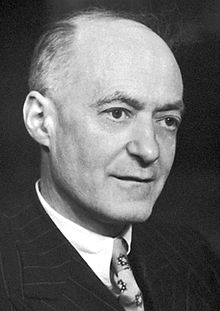Cyril Norman Hinshelwood
Cyril Hinshelwood OM PRS | |
|---|---|
 | |
| Born | Cyril Norman Hinshelwood 19 June 1897 London, England |
| Died | 9 October 1967 (aged 70) London, England |
| Alma mater | University of Oxford |
| Awards |
|
| Scientific career | |
| Fields | Physical chemistry |
| Institutions |
|
| Doctoral advisor | Harold Hartley |
| Doctoral students | Sydney Brenner Alan Eddy |
| Other notable students | Keith J. Laidler (postdoc) |
Sir Cyril Norman Hinshelwood OM PRS (19 June 1897 – 9 October 1967) was a British physical chemist and a Nobel Prize laureate.[4][5]
Education[]
Born in London, his parents were Norman Macmillan Hinshelwood, a chartered accountant, and Ethel Frances née Smith. He was educated first in Canada, returning in 1905 on the death of his father to a small flat in Chelsea where he lived for the rest of his life. He then studied at Westminster City School and Balliol College, Oxford.
Career[]
During the First World War, Hinshelwood was a chemist in an explosives factory. He was a tutor at Trinity College, Oxford from 1921 to 1937 and was Dr Lee's Professor of Chemistry at the University of Oxford from 1937. He served on several Advisory Councils on scientific matters to the British Government.
His early studies of molecular kinetics led to the publication of Thermodynamics for Students of Chemistry and The Kinetics of Chemical Change in 1926. With Harold Warris Thompson he studied the explosive reaction of hydrogen and oxygen and described the phenomenon of chain reaction. His subsequent work on chemical changes in the bacterial cell proved to be of great importance in later research work on antibiotics and therapeutic agents, and his book, The Chemical Kinetics of the Bacterial Cell was published in 1946, followed by Growth, Function and Regulation in Bacterial Cells in 1966. In 1951 he published The Structure of Physical Chemistry. It was republished as an Oxford Classic Texts in the Physical Sciences by Oxford University Press in 2005.
The Langmuir-Hinshelwood process in heterogeneous catalysis, in which the adsorption of the reactants on the surface is the rate-limiting step, is named after him. He was a senior research fellow at Imperial College London from 1964 to 1967.
Awards and honours[]
Hinshelwood was elected Fellow of the Royal Society (FRS) in 1929,[2] serving as President from 1955 to 1960. He was knighted in 1948 and appointed to the Order of Merit in 1960. With Nikolay Semenov of the USSR, Hinshelwood was jointly awarded the Nobel Prize in Chemistry in 1956 for his researches into the mechanism of chemical reactions.
Hinshelwood was President of the Chemical Society, the Royal Society,[2] the Classical Association, and the Faraday Society, and received numerous awards and honorary degrees.
Personal life[]
Hinshelwood never married. He was fluent in seven classical and modern languages and his main hobbies were painting, collecting Chinese pottery, and foreign literature.
He died, at home, on 9 October 1967. In 1968 his Nobel Prize medal was sold by his estate to a collector, who then sold it in 1976 for $15,000.[6] In 2017 his Nobel Prize medal was sold at auction for $128,000.[7]
See also[]
References[]
- ^ Cyril Norman Hinshelwood on Nobelprize.org

- ^ Jump up to: a b c Thompson, H. (1973). "Cyril Norman Hinshelwood 1897–1967". Biographical Memoirs of Fellows of the Royal Society. 19: 375–431. doi:10.1098/rsbm.1973.0015. PMID 11615727. S2CID 12385145.
- ^ Hinshelwood Archives at the Royal Society
- ^ Cullis, C. F. (1945). "Obituary: Cyril Norman Hinshelwood, Kt., O.M., M.A., D.Sc., F.R.S., 1897?1967". Journal of the Chemical Society (Resumed): X001–X002. doi:10.1039/JR945000X001.
- ^ Rowlinson, J. S. (2004). "The wartime work of Hinshelwood and his colleagues". Notes and Records of the Royal Society. 58 (2): 161–175. doi:10.1098/rsnr.2004.0050. PMID 15209074.
- ^ "Nashua Telegraph". 8 March 1976. p. 20.
- ^ Watson, Norman. "Scientists prize-winning work revealed by rare Nobel medal".
External links[]
- Cyril Norman Hinshelwood on Nobelprize.org
 including the Nobel Lecture on December 11, 1956 Chemical Kinetics in the Past Few Decades
including the Nobel Lecture on December 11, 1956 Chemical Kinetics in the Past Few Decades
- 1897 births
- 1967 deaths
- Scientists from London
- English physical chemists
- Knights Bachelor
- Nobel laureates in Chemistry
- British Nobel laureates
- Fellows of the Royal Society
- Presidents of the Royal Society
- Alumni of Balliol College, Oxford
- Fellows of Trinity College, Oxford
- Members of the Order of Merit
- Recipients of the Copley Medal
- People educated at Westminster City School
- Royal Medal winners
- Faraday Lecturers
- Presidents of the British Science Association
- Foreign Members of the USSR Academy of Sciences
- English Nobel laureates
- Dr Lee's Professors of Chemistry
- Academics of Imperial College London
- Foreign associates of the National Academy of Sciences
- Recipients of the Dalton Medal
- Manchester Literary and Philosophical Society
